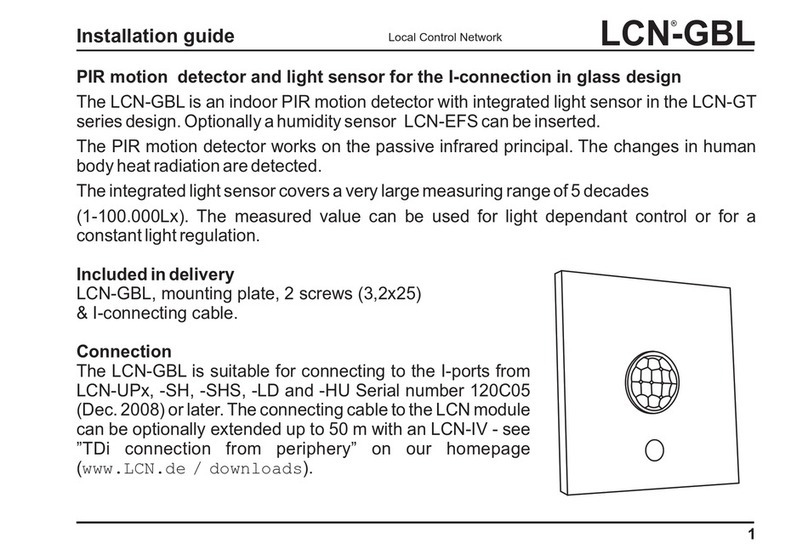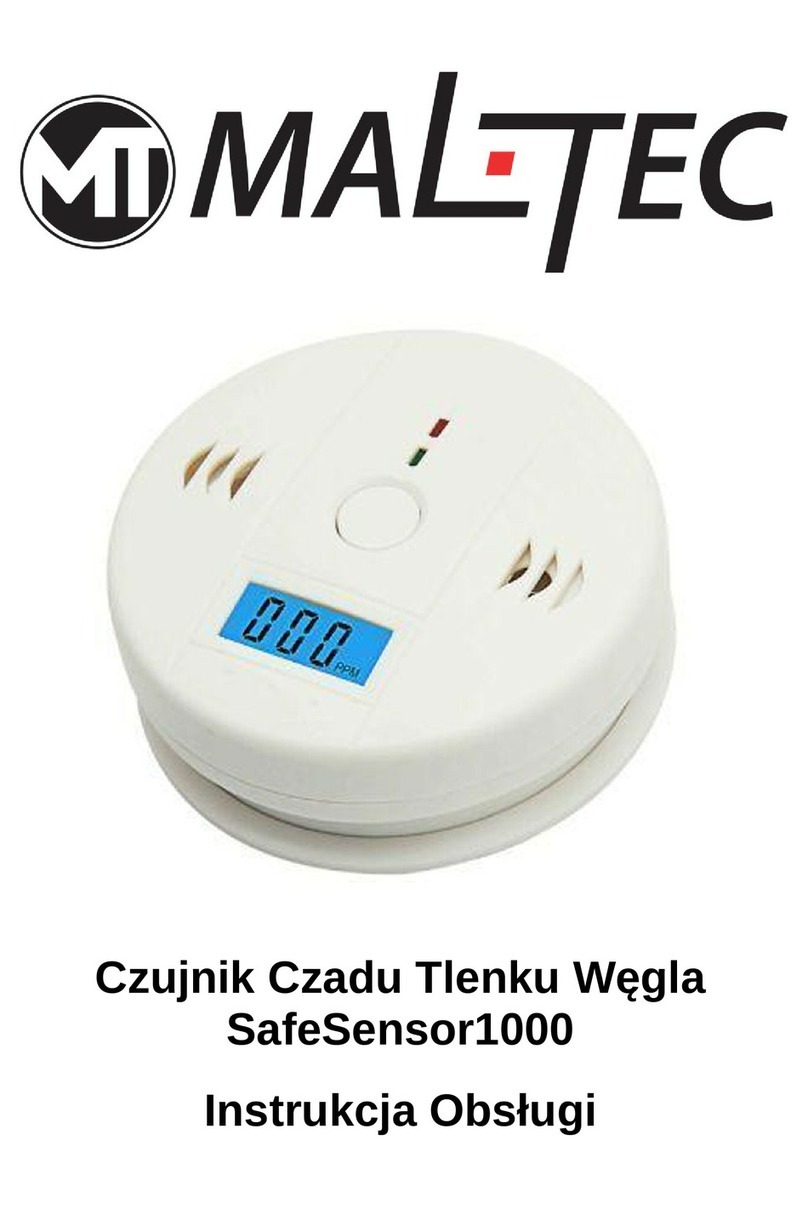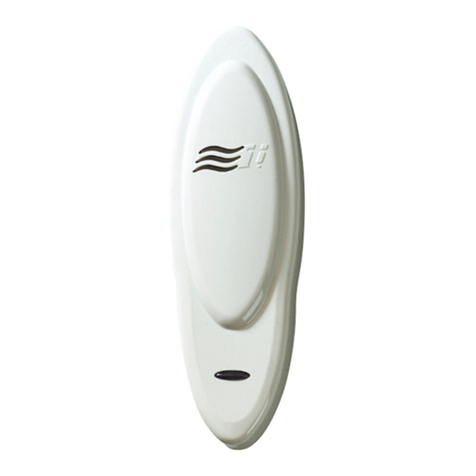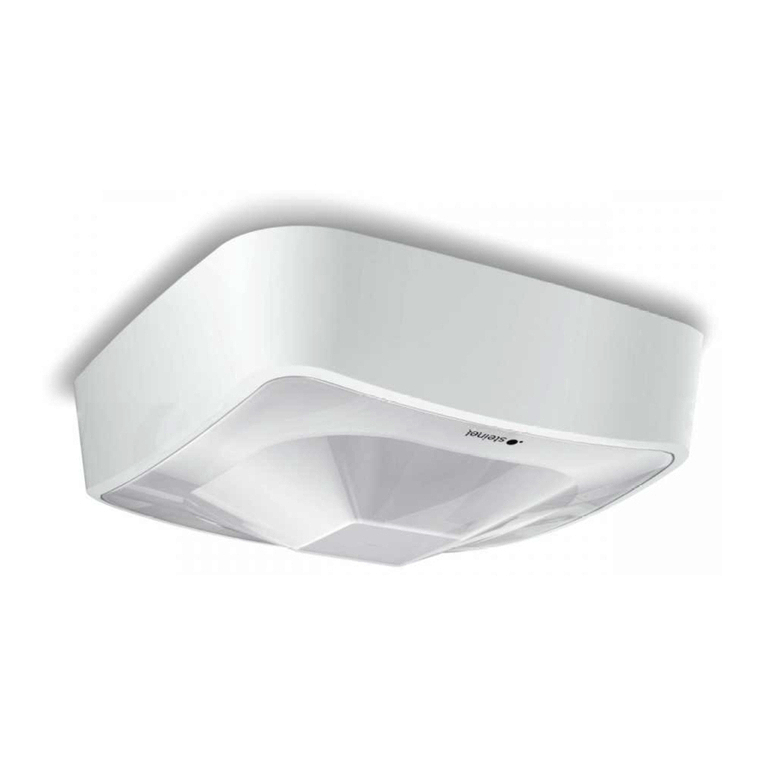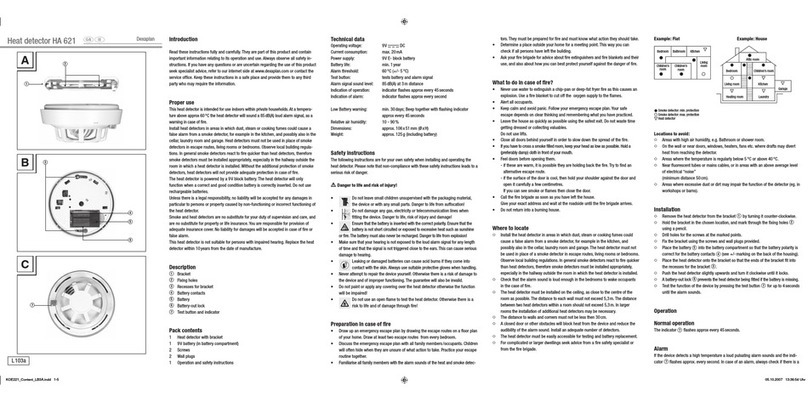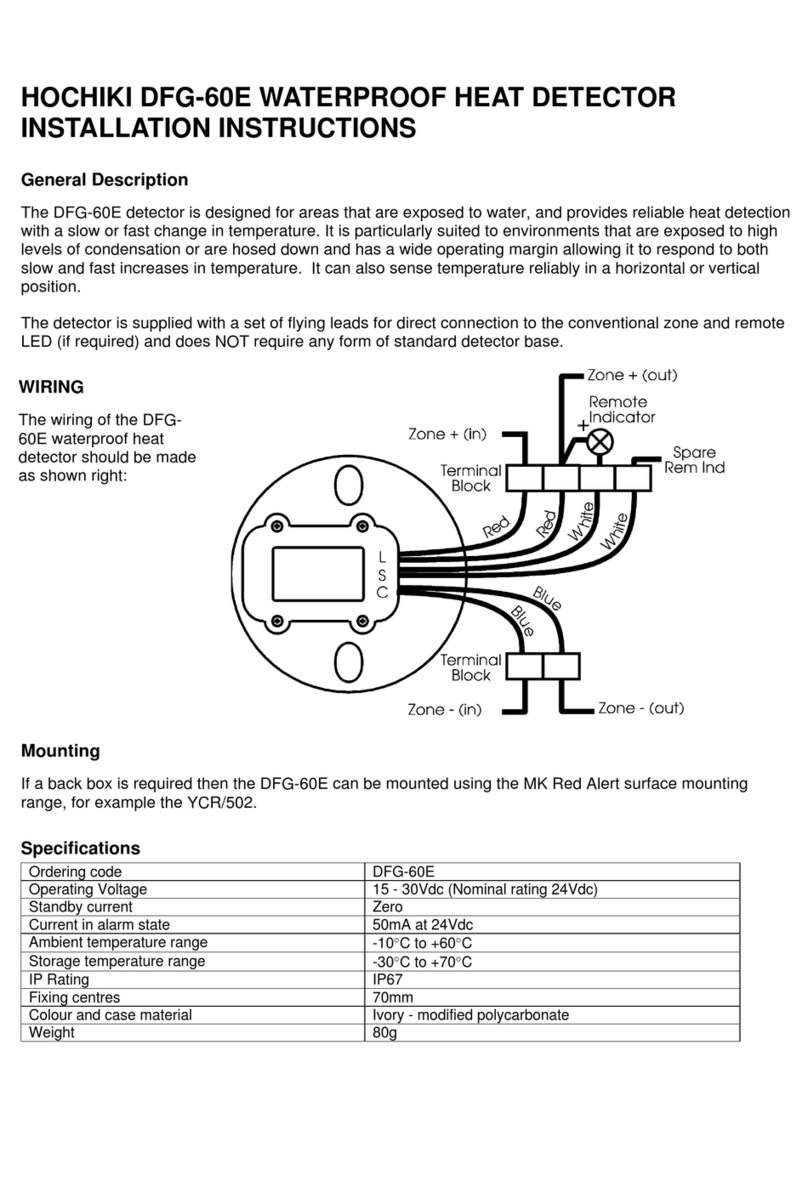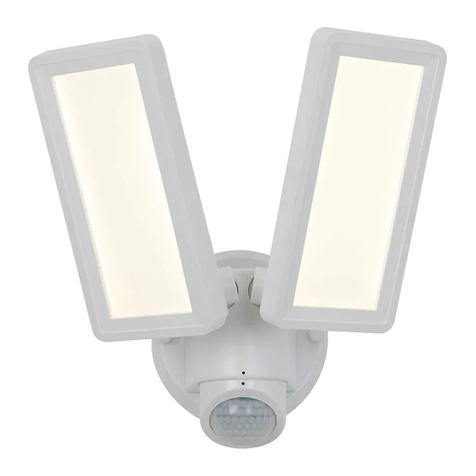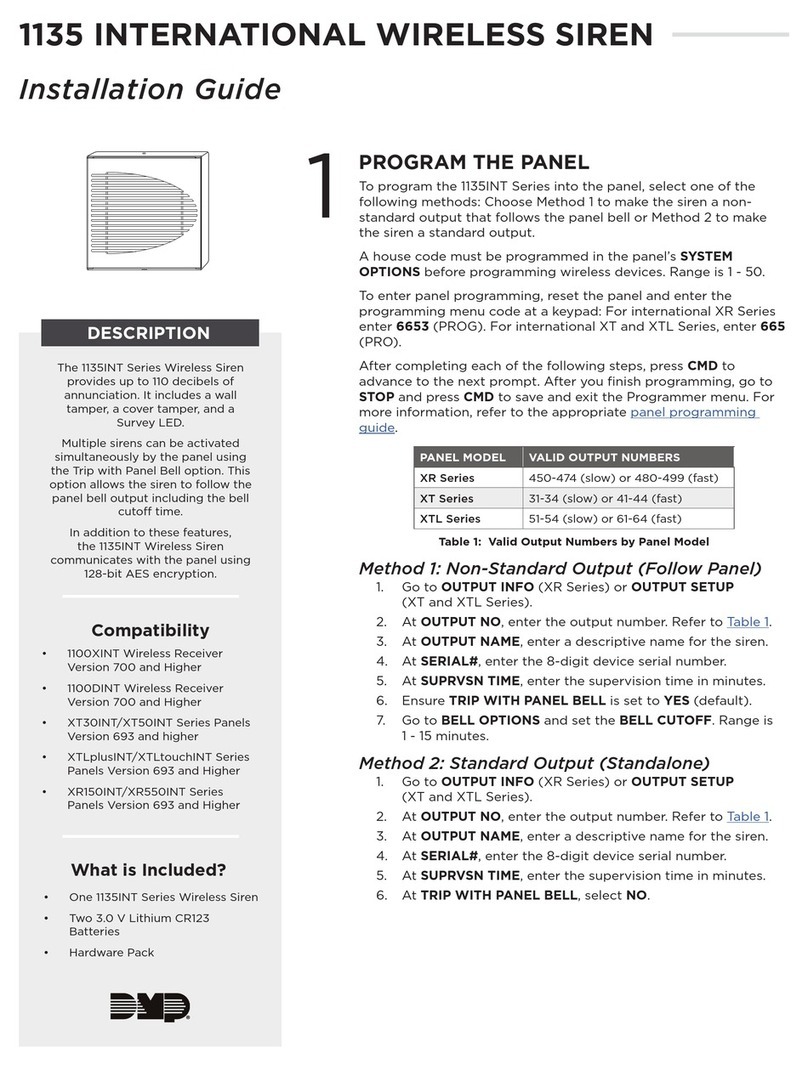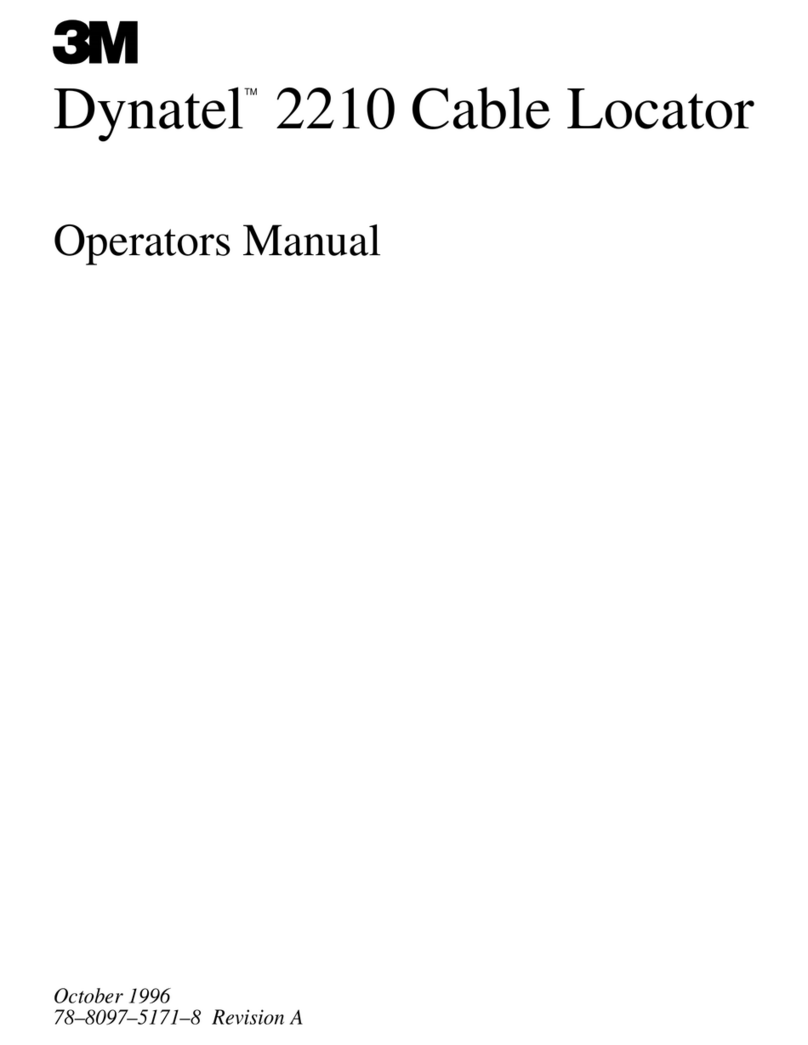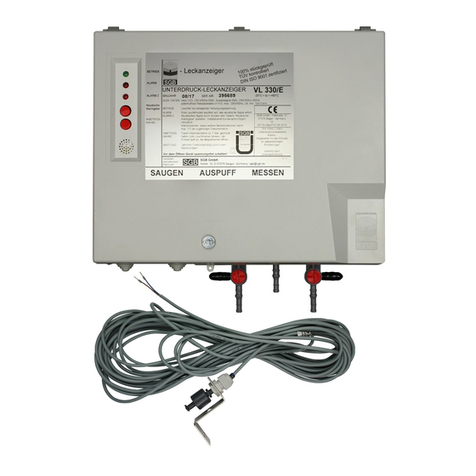LCN 8310-804 User manual

75.5318.00 20080111 Page 1 of 9
DESCRIPTION
TECHNICAL
SPECIFICATIONS
INSTALLATION
TIPS
The sensor must be
firmly fastened to
prevent v bration.
COMPONENT ID
The Door Mounted Safety Sensor (DMSS) (8310-804) detector is a door-mounted presence detection system that is used on
automatic pedestrian swing doors. Unlike other door-mounted sensing devices, the sensors unique electronic architecture allows
the detection modules to be mounted near the top of the door, out of harm's way. A rotating cam is used for the range adjustment
of the detection zone. Width patterns may be altered by adding slave modules to the master module. These slave modules are
simply added by inserting them into the aluminum extrusion, then connecting them with the attached flat ribbon cable to the next
module without interrupting other modules in the same extrusion. Once installed, the detection zone (in addition to being
adjustable for distance) can be angled independently from the other modules.
Each DMSS module consists of two optics, a transmitter (TX) and a receiver (RX), and functions independently of the other
modules. The transmitter emits an extremely precise beam, which measures approximately 4" in diameter at a distance of 8'.
The receiver, in turn, receives the infrared beam reflected off of the floor. This transmission and reception forms a detection
triangle, which is the basic premise of detection (called triangulation). Should this angle be interrupted, detection will occur.
Detection is NOT based upon the intensity of the beam, and in principle will not be affected by the color or background of the
object that interrupts the angle.
DESCRIPTION SPECIFICATION
Power Supply 12 to 24 VAC ± 10% / 12 to 24 VDC + 10%
Current Consumption:
Master: On = 60 mA max. / Master: Off = 30 mA max.
Slave: On = 40 mA. Max. / Slave: Off = 30 mA max.
Input Inhibit 12 to 24 VAC ± 10%: / 12 to 24 VDC + 10% / Inhibited when voltage is applied
SMR Input Data 12-18 VDC: Inhibited when voltage is applied
Output Interface; relay Relay; max. contact rating is 1A @ 30v ( resistive)
Detection Range 0' to 8'
Distance Adjustment 2’ to 8’ / Rotating cam with linear adjustment
Max. Mounting Height 8’
Detection Time < 50 ms
Detection Signal Duration Infinite Presence Detection
Output Hold Time Potentiometer Range: 0.1 to 4.5 seconds.
LED Indications Master: Red LED = Detection
Green LED = Active Output
Slave: Red LED = Detection
Operating Temperature Range -30° F to 140° F
PCB Dimensions Master: 10.91" x 1.5"
Slave: 8.75" x 1.5"
Connection to Door Controller 8 Position Screw Terminal on Master PCB
Connection: Master to Slave Flat R bbon Cable With Connectors and Key Lock
Max. Number of Slaves Standard = 9 / With Monitoring = 8 max.
Functions Selection Detection Mode - NO or NC
Normal Mode or Background Analysis Mode
Sensor must be in a location
that does not interfere with door
hardware (finger guards, lock
rods, etc.
)
.
The sensor must not
have any unwanted
objects likely to move or
vibrate in its path.
DOOR MOUNTED
SAFETY SENSOR
DMSS
Quick Disconnect Cable
(8310-847) Jamb Cap (2)
8310-804 DOOR MOUNTED SAFETY SENSOR
USER’S GUIDE

75.5318.00 20080111 Page 2 of 9
SAFETY
PRECAUTIONS
MECHANICAL
INSTALLATION-
PREPARING AND
MOUNTING THE
SENSOR
CAUTION: REMOVE THE MASTER AND ALL SLAVE CIRCUIT BOARDS FROM THE ALUMINUM
EXTRUSION BEFORE PERFORMING ANY DRILLING. WHEN COMPLETE, ENSURE
THAT ALL METAL SHAVINGS ARE CLEANED FROM THE EXTRUSION BEFORE
RE-INSERTING THE CIRCUIT BOARDS.
•Shut off all power going to the header before attempting any wiring procedures.
•Maintain a clean & safe environment when working in public areas.
•Constantly be aware of pedestrian traffic around the door area.
•Always stop pedestrian traffic through the doorway when performing tests that may result in unexpected
reactions by the door.
•Always check placement of all wiring and components before powering up to ensure that moving door parts
will not catch any wires and cause damage to equipment.
•Ensure compliance with all applicable safety standards (i.e. ANSI A156.10 / 19) upon completion of installation.
1. Install push or pull arm.
2. Remove the screw that secures the end cap to the Door Mounted Safety Sensor extrusion (as shown in Picture 1 below).
3. Remove the plastic lens by pulling the lens out from the top of the extrusion (as shown in Picture 2 above). Do not use a
screwdriver to pry the lens, as cracking may occur.
4. Picture #3 below shows the angle adjustment clip in its proper position within the extrusion (PCB’s are removed, and clip
is shown at end of extrusion for clarity only). To remove the clip, simply pull the tab out away and downward from the
extrusion, then rotate the module out from extrusion as shown in picture #4. To re-install, simply reverse the procedure -
the PCB must first be installed into the adjustment clip, then installed into the aluminum extrusion.
IMPORTANT NOTE: The end of the extrusion that is towards the pivot end of a center hung door, should be in far
enough from the edge of the door, as shown in picture #5, to prevent the end cap of the DMSS
from rubbing against the finger guard during door movement. Pay particular attention on the safety
side of the door. Hinge hung doors will not require as much clearance between the end of the DMSS
and hinge-side jamb as shown in picture #6 below. At the leading edge of the door the edge of the
DMSS, including the end cap, should be as close as possible to the leading edge of the door without
creating mechanical interference with the door jamb or with an adjacent door (pairs)
.
1 2
3 4
5 6
!
CAUTION
NOTE: If a brick store front is encountered during installation, route the sensor wiring through the door header.

75.5318.00 20080111 Page 3 of 9
MECHANICAL
INSTALLATION-
PREPARING AND
MOUNTING THE
SENSOR (Cont’d)
5. Hold the Door Mounted Safety Sensor extrusion up to the top of the door. Insure that the extrusion is oriented
correctly as shown below.
6. Mark and drill the extrusion (as shown in pictures 8, 9 and 10 below) where the mounting holes (one at each end)
should be located. Also, be sure to mark and drill the proper end for an additional hole to be used for wire passage.
Wire passage hole should be approximately ¼” diameter. Screw mount holes only serve as a pilot hole for ease of
installing the self-drilling screws that are provided.
7. Hold the DMSS back up to the door at the pre-drilled location and attach the unit to the door with the 2 screws
provided (as shown in picture 11 below). Insure the DMSS extrusion is tight against the door.
8. If Door Mounted Safety Sensors are to be mounted on both sides of the door, a wire passage hole will be required
through the door to go from the approach side to the safety side, as shown below. Again, be sure not to drill through
any through-bolts or braces within the door. A cutaway view below (Picture 13) shows wire passage through the
door. Picture 12 and 14 shows an approximate location for the wire passage hole. The extension wire going between
the terminal blocks should be approximately 18” long and can then be cut back if needed. Refer to the detailed
drawing below for wire routing, connector and cable location.
Back Side
Top Side
NOTE: Take care to avoid screw holes near the seams of the door, where it may be difficult to drill and install
a screw, and possibly damage the inside structural braces of the door.
7
8 9 10 11
12 13 14
DMSS units mounted on eithe
r
side
o
f
doordirectly opposite each other
Drill wire access hole through
back plates and both sides o
f
door For clarity,DMSS covers and
internal components (except
connectors) not shown,
units shown exploded
of
f
door, door shown cut away
Route this endo
f
cable to control
box in header
Connector Inside unit
Cable (8310-847)
Connector
inside
unit
Doo
r
Flextube
enters
unitonsecure
side o
f
doo
r
Operatorarmand/o
r
track(shown)
must be installedprior to sensors to
avoidinterference

75.5318.00 20080111 Page 4 of 9
ELECTRICAL
INSTALLATION-
CABLING &
CONNECTIONS
MECHANICAL
INSTALLATION-
PREPARING AND
MOUNTING THE
SENSOR (Cont’d)
9. Next, a wire passage hole will be required in the door header (Picture 15) and also in the jamb tube (Picture 16) at
approximately the same height as the Door Mounted Safety Sensor. The wire transfer hole in the jamb should be at
the secure side of the door. Normally this would be the interior side. Feed the wire through the jamb tube up to the
header. Insure that enough wire is left out to reach the Door Mounted Safety Sensor terminal block.
10. Once all cabling is in place, the plastic sheath must be installed over the wire coming out of the jamb tube. This must
be done before making final connection to the terminal block. The sheath may have to be cut to fit the application.
Once the wire is fed though, the plastic cap may be installed on the jamb, over the transfer hole.
1. With cabling in place, wiring at the terminal connector on the DMSS master module (picture 20) may be completed.
Wiring will vary according to the application. Available positions on the connector are shown below:
TERMINAL EXPLANATION OF WIRING CONNECTIONS
1 TST TEST DATA - Used with SMR systems only.
2 GND GROUND - Negative terminal if Input inhibition is used.
3 INH INPUT INHIBITION - All detection is ignored. Infrared emission is stopped. Inhibition occurs
when 12 to 24 VAC ± 10% or 12 to 24 VDC + 10% is applied between terminal 3 and
terminal 2.
4 NO In the relay mode, depending on the position of JP2 this terminal will provide either a NO or
NC contact. (JP2 factory default will result in NC on terminal 4)
5 NC In the relay mode, depending on the position of JP2, this terminal will provide either a NO or
NC contact. (JP2 factory default will result in NO on terminal 5)
6 COM COMMON - Contact for relay.
7 - NEG. POWER - This terminal is used for power input. A voltage of 12 to 24 VAC ± 10% or
12 to 24 VDC + 10% must be supplied.
8 + POS. POWER - This terminal is used for power input. A voltage of 12 to 24 VAC ± 10% or
12 to 24 VDC + 10% must be supplied.
NOTE: Ensure there is enough slack in cabling to allow adequate movement of the cable throughout the range
of door travel.
Plastic ribbed sheath
J2
J1 J4
J3
P1
1
15 16
17 18 19
20

75.5318.00 20080111 Page 5 of 9
ELECTRICAL
INSTALLATION-
CABLING &
CONNECTIONS
(Cont’d)
MECHANICAL
ADJUSTMENTS –
POSITIONING AND
ANGLING THE
MODULES
2. Once all wiring has been completed, the end caps and lens may be installed. At the DMSS end of the cable (picture
23), leave enough slack to allow a relaxed connection at the terminal block. Locate the DMSS end cap that goes
towards the hinged end of the door. Remove the tab at the bottom of the cap (picture 21) to allow insertion of the plastic
sheath. Insert the plastic sheath (picture 22) and install the end cap. The DMSS lens may then be installed to fit tight
against the end cap and plastic sheath to hold it in place, as shown in picture 24. Leave the end cap off at the opposite
end until all mechanical adjustments have been completed.
* REFER TO THE BACK OF THIS GUIDE FOR WIRING SCHEMATICS.
1. The positioning of the modules within the aluminum extrusion will be as shown below. The modules will always be
positioned so that the transmitter (TX) is at the leading edge of the door. Modules may be flipped around to accommodate
handing of doors.
Approach Side
Safety Side
Hinge Side
Leading Edge
Side
Slave module
Master module
Door Cord
(must be placed on interior of door
)
TX RX TX RX
Master ModuleSlave Module
O
U
T
P
U
T
I
N
P
U
T
Ribbon Cable
Ribbon Cable
21 22 23 24

75.5318.00 20080111 Page 6 of 9
POWER-ON
POSITIONING,
ANGLING AND
ADJSUTING THE
MODULES
MECHANICAL
ADJUSTMENTS –
POSITIONING AND
ANGLING THE
MODULES
(Cont’d)
2. The angle of each module may be set independently. Use the charts below to help determine the angling. The angles may
have to be altered once the units have been powered up and walk-tested.
DMSS
R
Cardboard
SIDE VIEW
DOOR
VIEW FROM ABOVE
DMSS
Cardboard
IR
3. The following procedures will be used to adjust each module’s detection zone upon power-on, and must be made with the
Background Analysis jumper set to ‘Normal Mode’.
Power the sensors up with 12 to 24 VAC ± 10% or 12 to 24 VDC + 10%. LED status should reflect what
was configured for the relay output.
Use a white, gray, or black piece of cardboard about 8" x 11" and hold it as shown in the diagram above.
Move the cardboard from the floor upward until it is detected. This will determine the height of the dead
zone (B distance).
Measure the height at which the cardboard was detected.
If this height does not fall between 12" & 16" above the floor or does not meet your requirements, an
adjustment must be made to the detection distance.
DOOR MOUNTED SAFETY SENSOR ANGLE (C)
DEAD ZONE
DISTANCE FROM
FLOOR (B) 0° 5° 10° 15° 20° 25°
8" 0 6" 12 ½" 19 ¼" 26" 33 ¼"
12" 0 6" 12" 18" 24 ½" 31 ½"
16" 0 5 ½" 11 ¼" 16 ¾" 23 ¼" 29 ½"
20" 0 5 ¼" 10 ½" 16" 21 ½" 27 ½"
A
A
B

75.5318.00 20080111 Page 7 of 9
TROUBLE-
SHOOTING
COMPANY
CONTACT
POWER-ON
POSITIONING,
ANGLING AND
ADJSUTING THE
MODULES
(Cont’d).
One notch of the distance adjustment corresponds to approximately 4".
If Zone B is too high: Turn the distance adjustment clockwise to increase the detection distance and to
decrease Zone B.
If Zone B is too low, turn the distance adjustment counter-clockwise to decrease the detection distance.
Per current ANSI A156.10, the detection zone must be within 28” of the floor. Ideally, each detector should
be adjusted so that detection occurs at 12” to 16” above the floor. Less than 12” of Zone B may result in
occasional false triggering of the sensor.
Once all sensors have been adjusted, activate the door several times and allow it to go through a full cycle
each time. Insure that no false triggering is occurring, as would be indicated by the door recycling or
stopping by itself at any point of travel.
Ensure compliance of all applicable safety standards (i.e. ANSI A156.10 / 19).
Install all remaining covers, end caps, screws, etc.
PROBLEM POSSIBLE CAUSE CORRECTIVE ACTION
Do not leave problems unresolved. If a satisfactory cannot be achieved after troubleshooting a problem, please contact
LCN at 1-800-526-2400. If you must wait for the following workday to call, leave the door inoperable until satisfactory
repairs can be made. Never sacrifice the safe operation of the automatic door or gate for an incomplete solution.
For more information, visit www.lcn.ingersollrand.com.
Door Mounted Safety
Sensor does not work at
all. No LED indications.
Faulty power supply
Faulty connections Power supply must be 12 to 24 VAC ± 10% or
12 to 24 VDC + 10%.
Check for this power at terminals 7 & 8 of the
affected DMSS module.
DMSS output appears to be
working opposite of what is
expected.
Relay output may be configured
improperly. Refer to Appendix for relay configurations. Be
sure to observe the LED indications on the
affected modules to help determine status.
Door stops by itself before
reaching the full open position. Safety side DMSS may be seeing
an adjacent wall or rail behind the
door near the open position.
Observe the LED status on safety side of door.
Find the Door Mounted Safety Sensor module
that is falsely being triggered. Check for:
Proper detection angle
Detection range adjustment
Door Mounted Safety Sensor may need to be
inh bited at a specific point of door travel at the
safety side for proper operation. Refer to the
terminal connections on page 4.
Detection Distance Adjustment
Activation or safety is being
held triggered. DMSS detection module may be
seeing the floor or unwanted
object near door.
Reduce the detection range on the affected
module(s). Detection should occur at 12” to
16” above the floor.
Erratic detection behavior is
occurring throughout the door’s
opening and closing cycle.
Possible faulty wiring at door
transfer location. Check each wire for continuity with as multi-
meter, at the transfer location. Move the
wires around during testing to help locate
any breaks. Replace faulty wiring as
necessary.
33

75.5318.00 20080111 Page 8 of 9
APPENDIX –
WIRING
DIAGRAMS

75.5318.00 20080111 Page 9 of 9
APPENDIX –
WIRING
DIAGRAMS
(Cont’d)
Table of contents
Other LCN Security Sensor manuals
Popular Security Sensor manuals by other brands
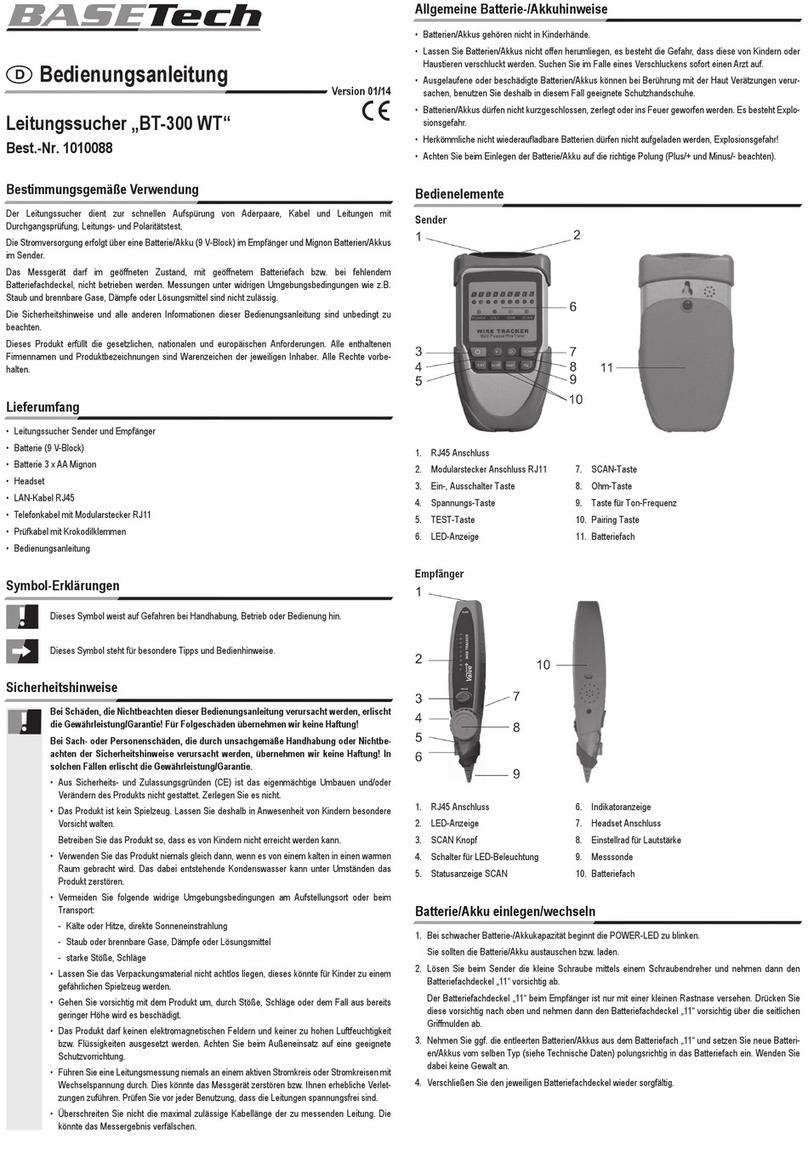
BASETech
BASETech BT-300 WT operating instructions
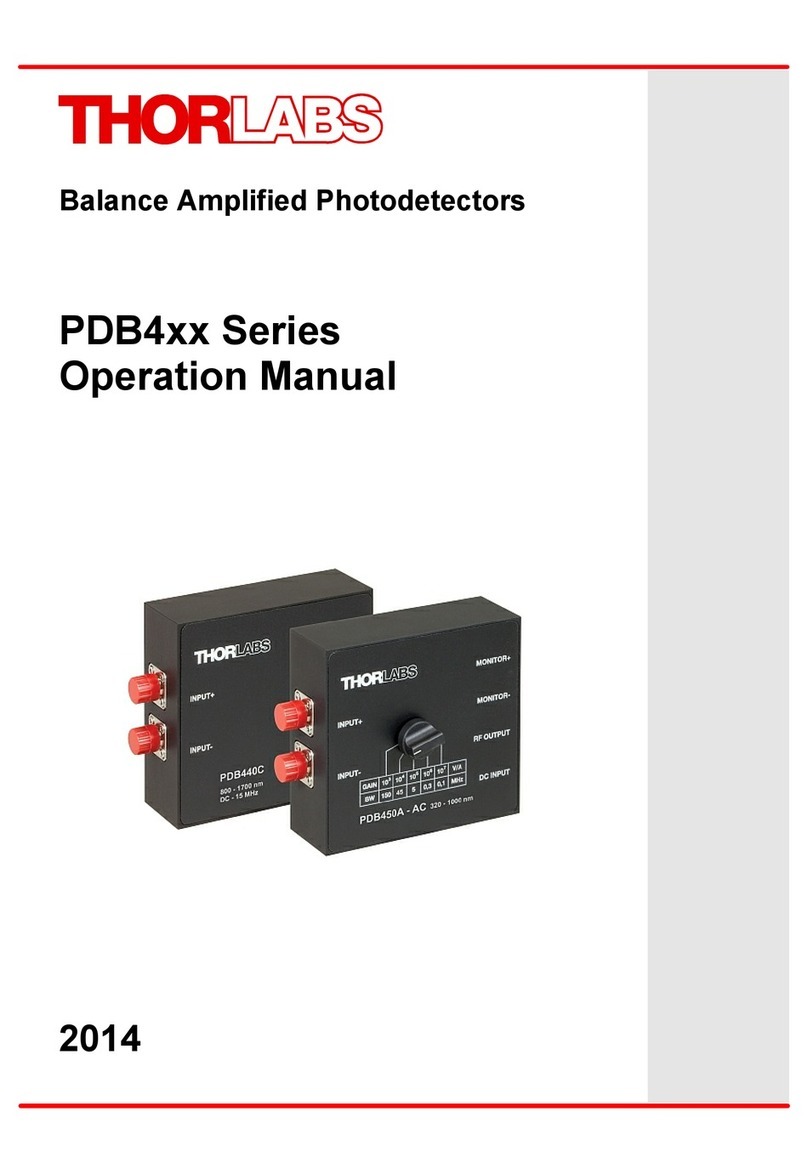
THORLABS
THORLABS PDB4 Series Operation manual

König
König SAS-ASDW4-QIG Series user manual
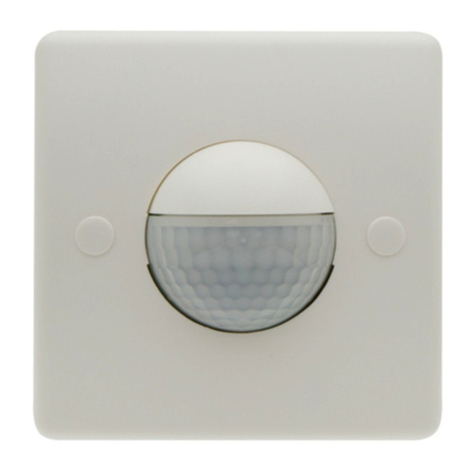
B.E.G. LUXOMAT
B.E.G. LUXOMAT Indoor 180-R/2W UK Operating and mounting instructions
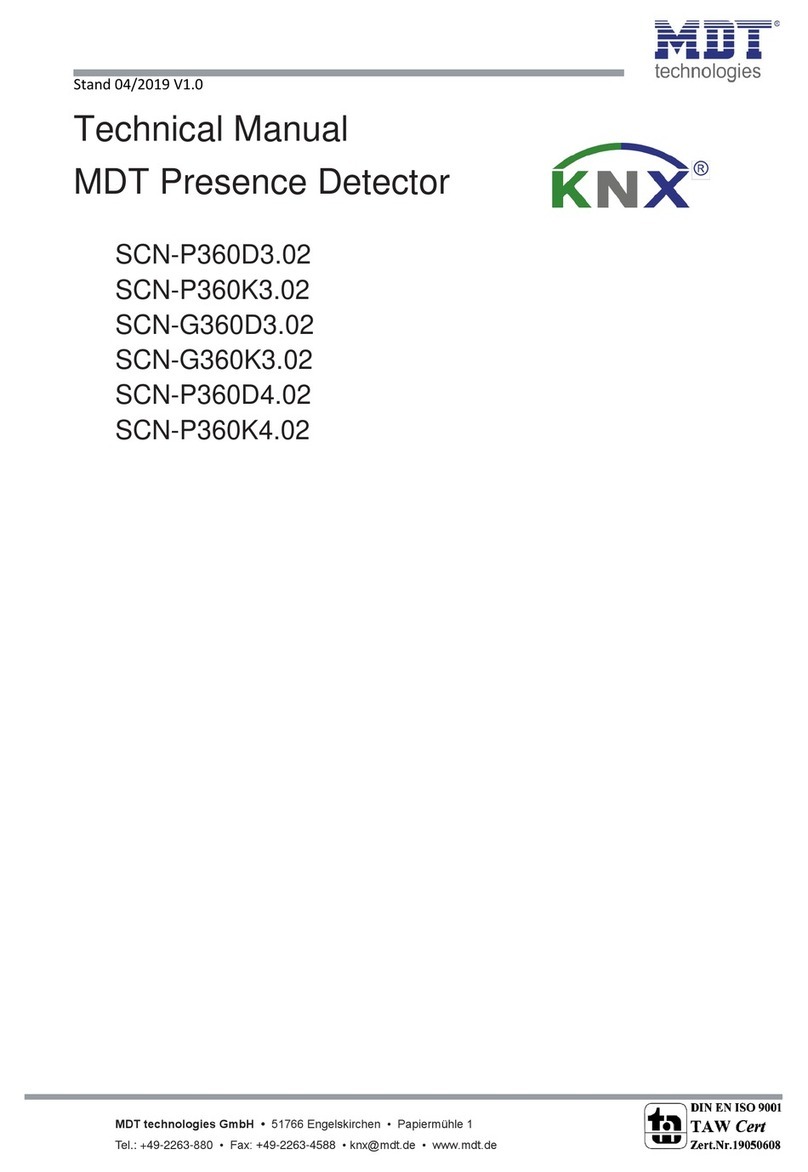
MDT Technologies
MDT Technologies SCN-P360D3.02 Technical manual
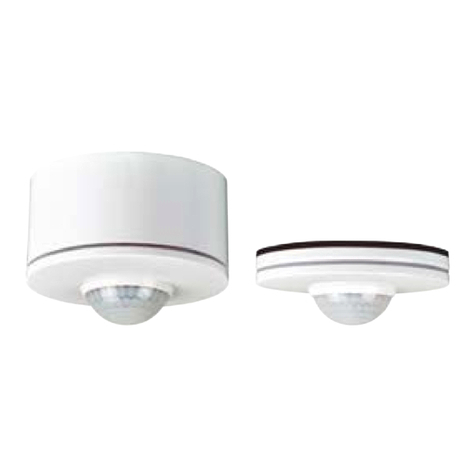
Niko
Niko 25264 quick start guide

